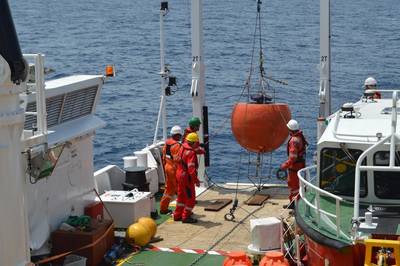Fugro said it has completed a 33-month period of metocean data acquisition for Hess Ghana Exploration Limited. Measurements were made at three locations in an area offshore western Ghana known as the Deepwater Tano/Cape Three Points block, in water depths of approximately 2,400 meters. The data are to be used by Hess in support of its operations in Ghana.
A Fugro-manufactured Wavescan buoy was deployed to measure waves, currents and meteorological and seawater parameters, with real-time data displayed on a project-specific webpage that was accessed by Hess via a secure log-in. A long mooring was deployed, measuring current profiles over the complete water depth, as well as seawater temperature and salinity. Fugro also deployed a short mooring to acquire near seabed currents. Data from both current moorings were stored on board the instruments’ internal memories and recovered during each of the service visits which were at three-month intervals.
Over the life of the project Fugro utilized vessels from its fleet, including the Fugro Frontier, to accomplish the nine site visits required, as well as vessels from the spot market. With the aim of pro-active cost reductions, vessel and personnel mobilizations were minimized by combining site visits with other Fugro operations in the region. After each service visit the metocean measurements were processed, analyzed and reported to provide Hess with quality controlled data detailing the metocean conditions in the area.
“We demobilized the equipment in June and we are now processing the data from the final phase,” said Jonathan Ainley, Commercial Manager at Fugro GEOS. “The final report will include data from each of the three stations over the complete duration of the project and will form part of the wider FEED study being carried out by Hess.” The information will be utilised for a number of engineering activities including riser and facilities design, fatigue calculations and operability calculations, as well as assisting decisions for physical construction at the field.


